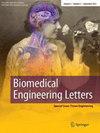Advancement of a RGBW-LED pen for diaphanoscopic illumination with adjustable color and intensity with tests on ex-vivo porcine eyes in terms of retinal risk and correlated color temperature
IF 2.8
4区 医学
Q2 ENGINEERING, BIOMEDICAL
引用次数: 0
Abstract
Abstract Diaphanoscopic illumination has the disadvantage that the intraocular spectrum is red-shifted due to transmission properties of the eyewall. This red-shift should be counteracted as well as the retinal risk should be reduced with adjusting the spectral distribution of the illumination light. Likewise, the illumination spectrum has to be adapted to the eye color of the patient. With the further development of a red, green, blue and white light-emitting diode (RGBW-LED) diaphanoscopy pen, the intensities of each color can be varied. The functionality of the LED pen is tested on ex-vivo porcine eyes. By measuring the transmission of the sclera and choroidea, the photochemical and thermal retinal hazard and the maximum exposure time are determined according to the standard DIN EN ISO 15004-2:2007. With this RGBW-LED pen the intraocular space can be illuminated clearly of up to 1.5 h without potential retinal damage according to DIN EN ISO 15004:2-2007. By adjusting the illumination spectrum the red-shift can be compensated and retinal risk can be reduced. By varying the LED intensities, the correlated color temperature in the eye can also be varied from cold white to warm white appearance as comfortable to the ophthalmologist. Additionally, a simple adjustment of the illumination to the eye color of the patient is possible. Using this RGBW-LED pen, the ophthalmologist can set the desired intraocular color appearance, which he prefers for special applications. He could also adjust the illumination to the eye color as this would reduce retinal hazard.一种可调颜色和强度的RGBW-LED透光笔的研制,并在离体猪眼上进行视网膜风险和相关色温的测试
摘要:透光镜照明的缺点是由于眼壁的透射特性导致眼内光谱发生红移。这种红移应该被抵消,以及视网膜的风险应该减少调整光谱分布的照明光。同样,照明光谱也必须适应病人眼睛的颜色。随着红、绿、蓝、白四色发光二极管(RGBW-LED)透光笔的进一步发展,每种颜色的强度都可以变化。LED笔的功能在离体猪眼睛上进行了测试。通过测量巩膜和脉络膜的透射率,根据DIN EN ISO 15004-2:2007标准确定视网膜的光化学和热危害及最大暴露时间。根据DIN EN ISO 15004:2-2007,使用RGBW-LED笔可以在1.5小时内清晰地照亮眼内空间,而不会对视网膜造成潜在损害。通过调节照明光谱可以补偿红移,降低视网膜风险。通过改变LED的强度,眼睛的相关色温也可以从冷白到暖白,这对眼科医生来说是舒适的。此外,对患者眼睛颜色的照明进行简单的调整也是可能的。使用这种RGBW-LED笔,眼科医生可以设置所需的眼内颜色外观,这是他喜欢的特殊应用。他还可以根据眼睛的颜色调整照明,这样可以减少视网膜的危害。
本文章由计算机程序翻译,如有差异,请以英文原文为准。
求助全文
约1分钟内获得全文
求助全文
来源期刊

Biomedical Engineering Letters
ENGINEERING, BIOMEDICAL-
CiteScore
6.80
自引率
0.00%
发文量
34
期刊介绍:
Biomedical Engineering Letters (BMEL) aims to present the innovative experimental science and technological development in the biomedical field as well as clinical application of new development. The article must contain original biomedical engineering content, defined as development, theoretical analysis, and evaluation/validation of a new technique. BMEL publishes the following types of papers: original articles, review articles, editorials, and letters to the editor. All the papers are reviewed in single-blind fashion.
 求助内容:
求助内容: 应助结果提醒方式:
应助结果提醒方式:


